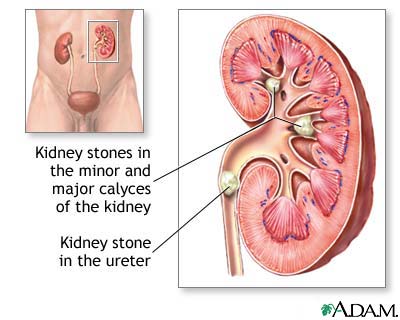Nephrolithiasis - definiton, symptoms and treatment

What is Nephrolithiasis and Definition
Nephrolithiasis is the formation of calcifications (also called calculi) in the KIDNEYS, usually called kidney stones. Kidney stones are common, with about 1 in 10 adults in the United States likely to have at least one over the course of adulthood. Some people pass kidney stones with little discomfort and may not even be aware of them, though for many people nephrolithiasis is extremely painful and debilitating. Kidney stones may lodge in the ureters or within the kidney, usually in the renal pelvis or a structure within the renal medulla called the calyx where the collection tubules empty their URINE.
Kidney stones that block the flow of URINE constitute a medical emergency that may require immediate treatment.
About 75 percent of kidney stones are made of calcium in combination with oxalate, phosphate, or carbonate. Calcium oxalate stones are the most common. About 10 percent of stones are made of uric acid and occur most frequently in men who have GOUT (a form of arthritis) or in people who are undergoing CHEMOTHERAPY. Other stones may form of cystine, an amino acid compound, or of struvite, a compound of magnesium, ammonia, and phosphate that tends to form in women who have frequent bacterial urinary tract infections (UTIs).
Symptoms of Nephrolithiasis and Diagnostic Path
Common symptoms of kidney stones include
- rapid onset of excruciating PAIN in the side (flank) or back
- persistent or colicky (wavelike) ABDOMINAL PAIN
- NAUSEA and VOMITING
- URINARY FREQUENCY and URINARY URGENCY
- FEVER and chills
- NOCTURIA (urination at night)
- groin pain in men or women or testicular pain in men
The diagnostic path may include abdominal XRAY, ULTRASOUND, OR COMPUTED TOMOGRAPHY (CT) SCAN to detect the location of the stone. The doctor may also choose to conduct an INTRAVENOUS PYELOGRAM (IVP) to assess the extent to which a stone is blocking the flow of BLOOD or urine. Blood and urine tests may show elevated levels of calcium, uric acid, or oxalate.
Nephrolithiasis Treatment Options and Outlook
Treatment for nephrolithiasis with severe pain begins with analgesic medication, often narcotic, to relieve the pain. Further treatment to move the stone out of the urinary tract may include EXTRACORPOREAL SHOCK WAVE LITHOTRIPSY (ESWL), a noninvasive method that effectively disperses stones up to 2 centimeters in diameter, or surgery such as percutaneous lithotomy in which the nephrologist uses laparoscopic surgery to snare and remove the stone. Most urologists prefer to take a course of watchful waiting with calculi that are not causing symptoms or that appear small enough to be able to pass through the urinary tract on their own, often recommending increased water consumption to increase the volume of the urine.
Kidney stones tend to recur, so often it is useful to determine the stone’s composition, as this helps the nephrologist or urologist assess appropriate measures to reduce the risk for future stone formation. The doctor will likely recommend straining the urine to capture the stones or stone fragments when they pass, for laboratory analysis. Despite the pain they cause, kidney stones do not usually cause permanent damage to the kidneys.
People who have had kidney stones should make dietary modifications, such as calcium restriction, only if the doctor specifically recommends them. Though doctors once believed dietary calcium was a key culprit in the development of kidney stones, recent research shows that when blood levels of calcium are too high (HYPERCALCEMIA) the cause is more likely to be overabsorption from the gastrointestinal tract than excessive consumption. Cutting back on dietary calcium in such a situation can have the opposite and undesired consequence of increasing gastrointestinal absorption of calcium. Dietary calcium is essential for BONE STRENGTH and health, tissue HEALING, and proper NERVE and MUSCLE function.
Nephrolithiasis - Risk Factors and Preventive Measures
Men are more likely than women to develop kidney stones. As well, kidney stones appear to run in families, suggesting a genetic or hereditary component. People who have RENAL TUBULAR ACIDOSIS or INFLAMMATORY BOWEL DISEASE (IBD) have increased risk for developing nephrolithiasis. Lifestyle measures to reduce the risk for kidney stones include drinking six to eight 8-ounce glasses of water and getting physical exercise daily. These measures increase the volume of urine, helping dissolve minerals that might crystallize, and keeps the urine moving through the urinary system. The doctor may prescribe medication to reduce the risk of kidney stones in people who have history of RECURRENCE.
See also CYSTINURIA; HYPEROXALURIA; MINIMALLY INVASIVE SURGERY; URINARY TRACT INFECTION (UTI); UROLITHIASIS.
Open discussion on the topic Nephrolithiasis - definiton, symptoms and treatment
Similar interests
- Nuovi Casino
- Casinos Not On Gamstop
- UK Casinos Not On Gamstop
- Casinos Not On Gamstop
- UK Casinos Not On Gamstop
- Casino Non Aams Italia
- Slot Sites Not On Gamstop
- Meilleur Casino En Ligne
- Non Gamstop Casino Sites UK
- Meilleur Casino En Ligne
- Casino En Ligne France
- Best Non Gamstop Casinos
- Casinos Not On Gamstop
- UK Casino Not On Gamstop
- Casinos Not Signed Up To Gamstop
- Best Slot Sites UK
- Non Gamstop Casino Sites UK
- Online Casinos Nederland
- Online Casinos Nederland
- Casinos Not On Gamstop
- Best New Uk Casinos Not On Gamstop
- Casino Non Aams
- Non Gamstop Casinos UK
- Migliori Siti Casino Non Aams
- Bitcoin Casinos